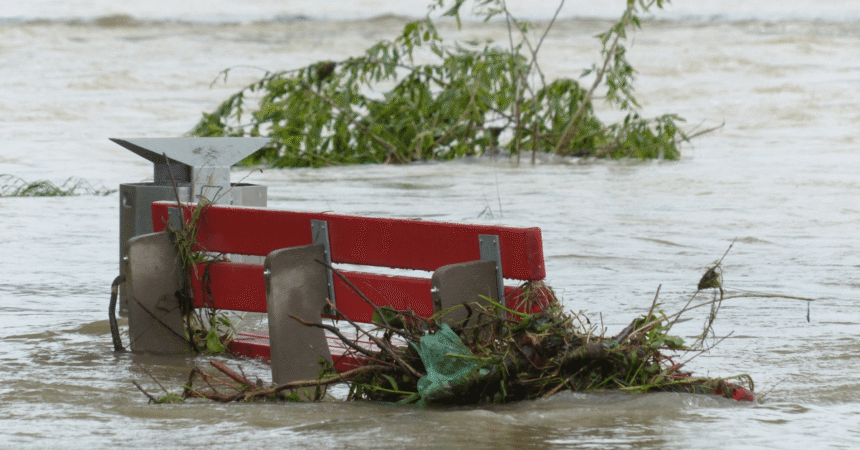Introduction
In eastern India, a devastating flooding crisis has unfolded, resulting in the loss of at least 26 lives and displacing over 250,000 people. The turmoil has brought to light not just the immediate humanitarian disaster but also the fraught political dynamics between the states of West Bengal and Jharkhand. West Bengal Chief Minister Mamata Banerjee has accused neighboring Jharkhand of exacerbating the situation by releasing water from dams, which she claims led to the severe inundation of her state. As both states engage in a public blame game, the crisis raises critical questions about infrastructure management, inter-state cooperation, and the broader implications of climate change on weather patterns in India.
The Immediate Impact of the Flooding
The flooding in West Bengal has left a trail of destruction, impacting countless lives and communities. Reports indicate widespread damage, with entire villages submerged and essential infrastructure, including roads and hospitals, rendered inoperable. Eyewitness accounts reveal harrowing scenes of families trapped in their homes, rescue teams navigating flooded streets in boats, and communities scrambling to find shelter. The local government has activated emergency protocols, but the scale of the disaster has overwhelmed available resources.
Pradip Maity, a railway employee from Ghatal, expressed the urgency of the situation, saying, “Most people in my village have taken shelter in relief camps. Boats are now the only mode of transportation here.” The distressing conditions underscore the immediate need for humanitarian aid, as families face uncertainty about their futures. Many have lost their homes, livelihoods, and access to basic services, heightening the need for coordinated disaster response efforts.
Political Finger-Pointing
As the crisis unfolds, the political landscape in eastern India has become increasingly polarized. Chief Minister Mamata Banerjee has been vocal in her criticism of the Jharkhand government, asserting that the decision to open the sluice gates of dams was both unnecessary and reckless. She has characterized the flooding as a “man-made” disaster, claiming that the release of water could have been avoided. In her statements to the media, she has emphasized the need for accountability and called for immediate action from the Jharkhand authorities.
In contrast, officials from Jharkhand, including Supriyo Bhattacharya, have defended their actions. Bhattacharya argues that the decision to release water was essential to prevent greater catastrophe, asserting that failure to do so could have resulted in significant damage to the dams and potentially catastrophic flooding in both states. This exchange of accusations highlights the strained inter-state relations and raises questions about governance and responsibility during disasters.
The political ramifications of the crisis extend beyond immediate blame. The response to the flooding may influence future electoral outcomes and public perceptions of leadership in both states. Political parties in both regions may leverage the situation to bolster their narratives, either highlighting their government’s response or criticizing opponents for perceived failures. The media coverage surrounding these events will likely shape public opinion, making it imperative for leaders to navigate the crisis with a focus on effective governance and accountability.
The Role of Dam Management
The management of dams and water resources is a critical issue in India, especially in regions like the Damodar Valley, where multiple states share water resources. The Damodar Valley Corporation (DVC), which manages several dams along the Damodar River, has faced scrutiny over its decision-making processes. The corporation has stated that it reduced water releases following a decrease in rainfall, but critics argue that this response came too late for many communities already affected by flooding.
Dam management practices are often criticized for their lack of coordination and transparency. In this case, the inability to communicate effectively between the two states has resulted in a breakdown of trust and accountability. Experts argue for a more integrated approach to water management, emphasizing the need for better communication and collaboration among states, particularly during times of crisis.
In light of the current flooding crisis, there are calls for a reevaluation of dam management strategies. The focus should shift toward proactive measures, including the establishment of early warning systems and comprehensive emergency response plans. Implementing these strategies can help mitigate the impact of future flooding events and build resilience within vulnerable communities.
Climate Change and Extreme Weather Events
The current flooding crisis cannot be understood without considering the broader context of climate change. Experts have noted that India is experiencing an increase in extreme weather events, including intense rainfall and flooding, as a result of changing climate patterns. The Indian Meteorological Department has warned that climate change is likely to intensify rainfall in certain regions, leading to more frequent and severe flooding incidents.
The monsoon season in India has already shown signs of unpredictability, with heavy rains causing havoc across several states. This year’s flooding is a stark reminder of the vulnerabilities faced by many communities, particularly those in low-lying areas. Climate change not only affects weather patterns but also intersects with socio-economic factors, making marginalized populations even more susceptible to disasters.
The interplay between climate change and disaster response is complex. On one hand, there is an urgent need for immediate humanitarian aid to address the suffering caused by current flooding. On the other hand, it is crucial to implement long-term strategies aimed at mitigating the impacts of climate change and enhancing community resilience. Policymakers must prioritize sustainable practices that not only respond to current crises but also prepare for future challenges.
Humanitarian Response and Recovery Efforts
As the scale of the disaster becomes clearer, the response from local and national governments, as well as NGOs, is of utmost importance. Relief efforts are underway, with food, water, and medical supplies being distributed to those in need. However, the effectiveness of these efforts is often hampered by logistical challenges posed by the flooding. Roads and transport networks have been severely impacted, making it difficult to deliver essential supplies to affected areas.
Community organizations and volunteers are playing a crucial role in the relief efforts. Their knowledge of the area and established relationships within the community enable them to respond effectively to immediate needs. Local leaders are often on the front lines of disaster response, coordinating efforts and mobilizing resources to support those affected. Their involvement is essential in bridging the gap between governmental aid and community needs.
Recovery from such disasters is a long-term process that extends beyond immediate relief. Infrastructure must be rebuilt, and livelihoods restored. Additionally, psychological support is crucial for individuals who have experienced trauma, loss, and displacement. Comprehensive recovery programs should include mental health services, economic support, and community rebuilding initiatives to foster resilience.
The long-term impacts of flooding can be profound. Families may face ongoing challenges in rebuilding their lives, and communities may struggle to recover economically. Sustainable development practices and community engagement are essential in ensuring that affected populations are not only supported in the short term but also empowered to build a more resilient future.
Policy Implications and Future Considerations
The flooding crisis raises significant questions about policy and governance in India, particularly concerning disaster preparedness and response. There is a pressing need for improved inter-state coordination and communication to mitigate the impact of future disasters. Collaborative frameworks that bring together various stakeholders—including state governments, local authorities, and civil society—can enhance resilience and improve disaster management outcomes.
Investing in infrastructure that can withstand extreme weather events is critical. This includes not only better dam management but also improved drainage systems, flood defenses, and early warning systems. Additionally, integrating climate change considerations into urban and regional planning can help build resilience against future disasters. Policymakers must prioritize climate adaptation measures and sustainable development practices to address the root causes of vulnerability.
Education and awareness campaigns are also essential in fostering a culture of preparedness. Communities need to be informed about the risks associated with flooding and the steps they can take to protect themselves and their properties. Training programs on disaster response and recovery can empower local populations, enabling them to play an active role in safeguarding their communities.
The Human Element: Stories of Resilience
Amid the turmoil, stories of resilience and hope emerge. Many individuals and families are banding together to support one another during this challenging time. Neighbors are sharing resources, helping each other navigate the complexities of evacuation and recovery. Local leaders are stepping up to provide guidance and assistance, ensuring that no one is left behind.
These acts of solidarity reflect the strength of community bonds, even in the face of adversity. They serve as a reminder that while disasters can disrupt lives, they also have the potential to galvanize communities and foster a sense of collective purpose. In the aftermath of the flooding, rebuilding efforts will not only focus on physical infrastructure but also on strengthening social ties and fostering community cohesion.
Conclusion
The recent flooding crisis in eastern India serves as a stark reminder of the complexities of disaster management in a changing climate. The interplay of politics, infrastructure, and climate change has significant implications for affected communities. As the situation develops, it is crucial for all stakeholders to prioritize effective responses and long-term strategies to mitigate the impacts of future disasters. The humanitarian crisis at hand must not only be addressed through immediate relief efforts but also through comprehensive policies that promote resilience and accountability.
Looking ahead, the need for collaboration among states, community engagement, and proactive planning cannot be overstated. The lessons learned from this crisis should inform future policies and practices, ensuring that vulnerable populations are better prepared for the challenges that lie ahead. Ultimately, a commitment to sustainability, social equity, and collective resilience will be vital in navigating the complexities of climate change and disaster response in India.
#IndiaFloods #ClimateChange #DisasterManagement #WestBengal #Jharkhand #HumanitarianCrisis #ExtremeWeather #PolicyResponse #Resilience







